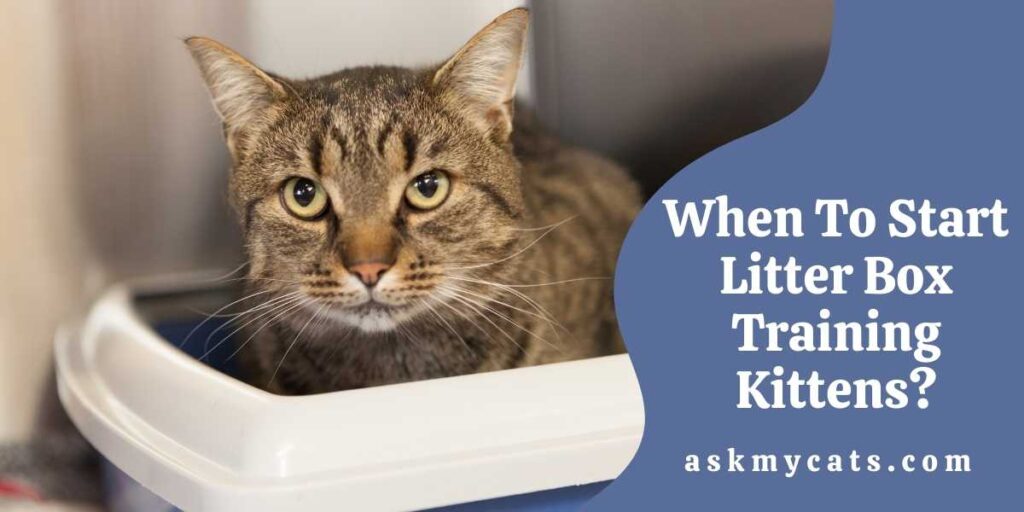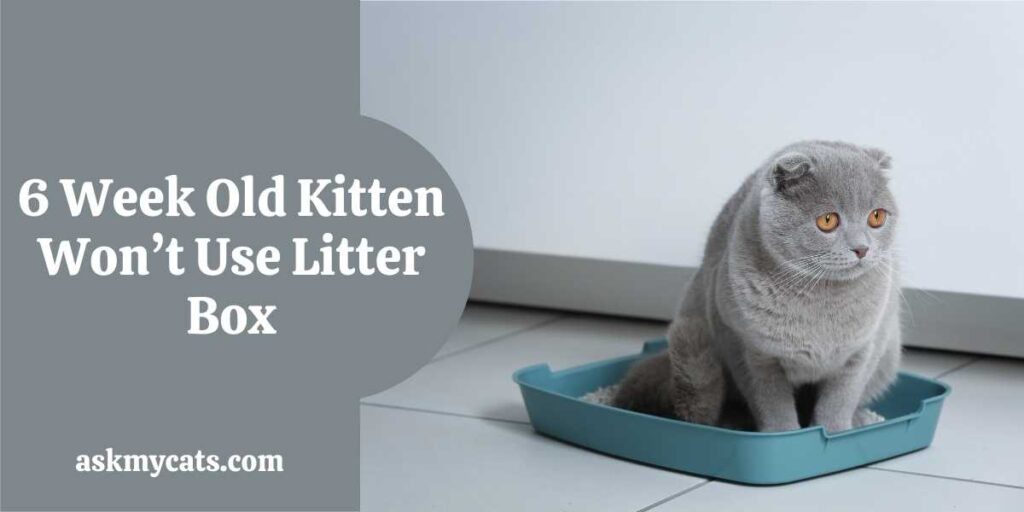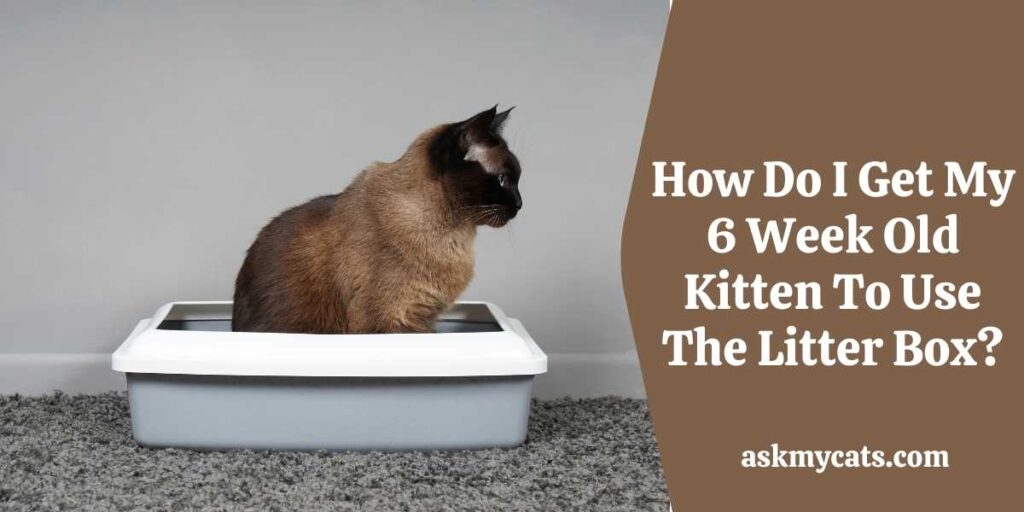If you’ve recently adopted a kitten, when and how to litter train a kitten is probably on your mind. It may come as a relief to learn that litter box training is usually straightforward.
Newborn kittens require stimulation to go to the toilet and not begin using the litter box until they are roughly three weeks old. When the kitten reaches the age of three weeks, it’s time to introduce them to the litter box.
Many kittens come in their new homes having learned to use a litter box from their mothers, and even those who haven’t been aided by a solid impulse to hide the evidence after they’ve done the job.
However, if your new kitten needs some guidance, the methods below should be helpful.


Give Your Cat the Perfect Day
Get the Free Ebook!
At What Age Do You Start Litter Training Kittens?
Litter training should be started at the age of 3 weeks for kittens.

If this is your first cat, you’ll want to start with two litter boxes since it’s a good idea to have one more than the number of cats using them. Please place them in locations that are both accessible and private. Your cat might not feel comfortable utilizing them if they’re too exposed.
There are several alternatives available, ranging from low-cost to high-end. You’ll discover a wide range of solutions, from low-cost non-clumping clay litter to high-end, environmentally friendly ones made from pine pellets, recycled newspaper, and even wheat.
While many cats aren’t fussy about the litter they use, some are. They won’t use litter if they don’t like the texture or smell.
Start with a regular, unscented clumping litter, and once your cat is thoroughly litter trained, you may try with anything else.
Reward your furry bundle of joy with a cat treat or a piece of dry cat food when you spot her using her box. To assist build pleasant connections with using the litter box, you can use toys and praise. You’ll have to wean them off, anticipating a food-related treat every time they use the box at some point.
How Do You Introduce A Kitten To A Litter Box?
To litter train a kitten, follow these steps:
- Show them the boxes as soon as they come by, placing the cat inside and allowing them to inspect and sniff them. Don’t rearrange the boxes once you’ve shown them to your cat to avoid confusion.
- After meals and when your cat wakes up from naps, place him in one of the boxes. Pick them up and place them in the litter box if you observe them acting like they need to go, including sniffing or crouching in a specific spot.
- When you observe them utilizing it, reward them. Praise them and reward them with a toy or a treat.
- Accidents should not be punished or chastised. This will increase tension and worry, worsening the condition and making training more difficult. Because cats don’t identify punishment with the occurrence in issue, it won’t help them learn not to do it again.
It’s critical to maintain the litter box properly. This will help to erase the terrible “cat odor” from your home, but it will also make using the litter box more enjoyable for your cat.
To remove your kitten’s deposits, scoop the box once a day. Soiled litter should be replaced as needed, usually when it stops regulating odor.
When you replace the litter, clean and disinfect the box, use water and mild soap or a water-white-vinegar combination. Use caution while using bleach, commercial disinfectants, or other strong chemicals that may hurt your cat.
Clean spots outside the box where your kitty has had accidents using an enzyme cleaner. This cleaning will remove the odor, which may attract them to return to that location if left untreated.
6 Week Old Kitten Won’t Use Litter Box
A 6-week old kitten won’t use his litter box because he doesn’t like the shape or size of the box.

Typically, older cats are seasoned litter box users by the time they come to live with you, but if the cat in issue was formerly an outdoor cat, you might face a litter box training problem.
Even yet, cats have all the instincts necessary to understand what a litter box is for rapidly. The most challenging part may be getting them acclimated to the trash.
In such instances, it is recommended that you start by filling the box with outside soil. As your cat becomes accustomed to using the litter box, gradually replace more of the dirt with cat litter to allow them to grow accustomed to the new surface.
The litter box’s location is critical in determining whether your kitten will use it. The ideal places to put it provide some seclusion while being accessible. If your cat spends a lot of time in various house areas, putting the litter box there is a smart idea.
It might be tempting for a kitten owner to hide the litter box out of sight, so it isn’t visible (or smelled). However, the kitten may avoid utilizing it if it isn’t close to where the cat typically spends its time.
Maintain a safe distance between the litter box and the kitten’s food and drink. It’s also a good idea to light the space, so the kitten doesn’t try to use the litter box in the dark. Consider what you would want in your bathroom; if it isn’t comfy for you, chances are it isn’t pleasant for your kitty.
Avoid relocating the litter box once you’ve shown it to your kitten, so you don’t confuse him.
How Do I Get My 6 Week Old Kitten To Use The Litter Box?
You have to clean and make the box suitable for use.

If they’re older cats, they can suffer from joint discomfort or stiffness, making it difficult to get to the litter box. Consider if the box’s sides are too high for them to climb over quickly or whether they’ll have to climb stairs or leap up on something to get to it.
Even after being thoroughly litter box trained, cats who have not been spayed or neutered may spray pee throughout the home to indicate their territory. Spaying or neutering a cat can often eliminate this habit.
There might be an underlying problem if your cat uses the litter box consistently for a long time and then stops or does so inconsistently. Because stress and worry might lead a cat to stop using the litter box, assess whether any significant changes in her surroundings have occurred, and see your veterinarian.
According to the ASPCA, not using the litter box is frequently an indication of an underlying medical condition, such as a urinary tract infection, which may become deadly if not handled.
You’re well on your way to a positive, harmonious relationship with your family’s newest member now that you’ve got everything you need to litter train your new cat.
Frequently Asked Questions
Are kittens litter trained at six weeks?
This MUST be done until they are at least four weeks old. They’ll be old enough to utilize a litter box by then. Some will do so without any training or supervision.
Can you take a six-week-old kitten home?
A 6-week-old kitten should be left with its mother. They want warmth, nourishment, and protection after they leave the womb, and who better to provide this than nature’s nurturer? Kittens should be left with their mothers for at least eight weeks if feasible.
Do kittens automatically use the litter box?
Although most kittens will use a litter box intuitively from a young age, having a basic understanding of cats and litter boxes can assist avoid issues from arising in the first place.
Final Words
Litter training your kittens should start at the age of 3-4 weeks old, and it shouldn’t be a challenging task because they often learn how to use the litter box within only a few days. However, you can do a few things to make it as stress-free and straightforward as possible for them.
Ask your questions in the comments section below.
